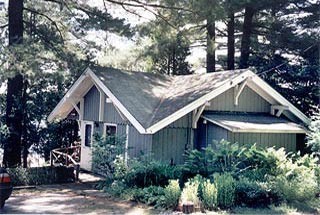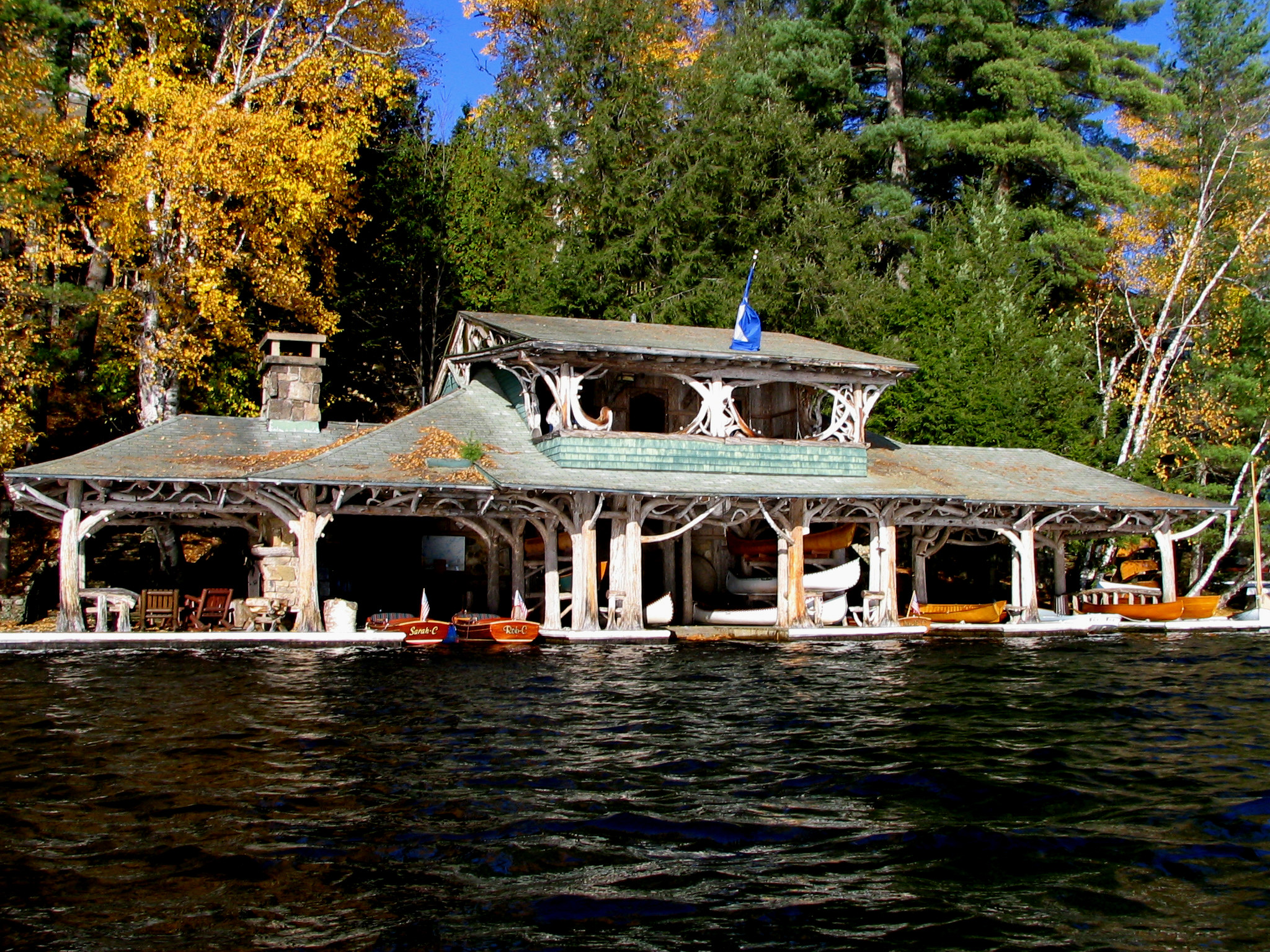In earlier posts, I have discussed that there are so many
fun things to do at White Pine Camp itself, that you could spend a delightful week there without ever leaving the camp's grounds. My own personal preference is to find a balance between activities at White Pine Camp,
climbing a few mountains and
doing other activities around the park. We like to alternate each day's focus between physically demanding activities -
typically mountain climbing - and
more relaxing activities.
Until now, I have resisted creating a list of "priorities" or even worse, a week-long activity list. As much as we love having a nice long list of things to do on vacation, it is at least as important for us to free ourselves from fixed schedules, agendas and strictly defined goals while we are on vacation. Our vacation is OUR time, and it is closely guarded.
The last thing I would want to do in creating a list of activities is to leave the impression that it represents what I want everyone to be doing during our week. No. If anything I write here sounds interesting and you are inspired to join us, that's great. If your preference is instead to kick back, drop your feet into Osgood Pond, read a book, take in the pine scented air - that's equally great. As the tongue-in-cheek title of this blog is "90th Birthday Get Together …," we are facing the reality that we are starting to get on in years. Accordingly, your preference might be to do something more ambitious still, like tackling Mt. Marcy in a day hike (
15 miles RT, 3166 ft ascent, 6 to 7 hours one-way for an experienced hiker).
Finally, in writing down ideas about how I might like to spend a week at White Pine Camp, I disavow any responsibility for spending the week as outlined here. I am equally happy to be inspired by others ideas as well! So, for what its worth, here is how a week at White Pine Camp
might be spent.
Several Times During The Week
Trips to the Snake Pit!! Confused?
See my earlier post on this subject to find out more.
Saturday
Check in is at 4:00 PM, so some of the activities will be pre check-in (
info.: White Pine Camp Policies and Procedures).
Depending on how far we travel to get to
White Pine Camp, we typically don't do much more than grocery shopping and getting settled in at camp. This year however, we may come to the Adirondacks before the beginning of our week at camp, so in addition to shopping, we might get in a moderate hike. Baker Mountain seems to be a perfect combination with shopping in Saranac Lake. The trailhead is right in the village and gives us a nice peek at the neighborhood.
-
Link to Trail description
Sunday
I am looking forward to spending a day on the water. We have previously made our way up the Osgood River and paddled the channel to Jones Pond, but we have not yet succeeded in getting to Church Pond. This is directly accessible from Osgood Pond via a series of canals. On our previous attempt, we were defeated by headwinds and were eventually pushed all the way back to the channel leading to Jones Pond. This time, the plan is to get an early start, before the wind kicks up.
The ambitious goal would be to then travel via canoe to Jones Pond, keeping a lookout for Loons, Mergansers, Beaver Dams (ok, we won't have to look out for those, we will have to cross over them on the way to Jones Pond) and Eagles.
An alternative plan may be to take the short drive in the car to
Adirondack Swim and Trip Camp (ASTC) which is on the eastern shore of Jones Pond. The latter option may actually be preferable as I have long neglected visiting friends at
ASTC, and I think that a visit might be in order that extends past sunset.
Learn more about my experiences as a child at ASTC from my previous post.
Monday
I have long had my eye on climbing Pitchoff Mountain, but haven't done this hike yet as the best way to do it is via a one way trail, with a car parked at each end. The folks at
ASTC consider it one of their favorite short climbs. As you can see from their picture below, the summit gives a very rewarding view.
Pitchoff Mountain
Distance to trailhead from White Pine Camp: 31 mi / 47 min
Elevation: 3500 ft / 1067 m
Vertical ascent: 1300 ft / 396 m
Round trip distance: 5.2 mi / 8.4 km
If we are a very ambitious bunch, we might actually consider also climbing Porter Mountain, which has a trailhead right across the street from Pitchoff. Typically, Cascade and Porter are done together as they share the same trail for most of the ascent, with the summit of Porter forking off the main path toward the top. In all honesty, Cascade has the better view of the two, but to date we have been atop Cascade and not Porter, so Porter is higher on the priority list. A friend at White Pine Camp recommends an alternative approach to Porter via Blueberry Mountain - which would turn it into a day trip in itself (
more about that in my previous post).
Porter Mountain
Distance to trailhead: 31 mi / 47 min (same parking area as Pitchoff Mountain)
Elevation: 4059 ft / 1238 m
Order of height: 38
Vertical ascent: 1960 ft / 598 m (or 3275 ft / 999 m from Marcy Airfield via Blueberry Mt.)
Round trip distance: 5.6 mi / 9 km (or 9 mi / 14.6 km from Marcy Airfield via Blueberry Mt.)
Tuesday
Typically
Ed Kanze gives a nature walk at White Pine Camp at 9:00. In spite of everything I have written about Ed
here,
here and
here, I have yet to actually meet him. In just a few days, I will be able to start reading his book!! What I already know about
Ed is that he is a great story teller and is very knowledgeable about the Adirondacks as well as the immediate area around Osgood Pond. And, I have every reason to believe that he is great with kids.
In the afternoon, an additional activity could be to visit the
Six Nations Indian Museum. I am sometimes critical of such museums as their authenticity can vary significantly. In this case, I am not concerned, as it it is family owned-Mohawk of Akwesasne. The
description of the museum on their website is really interesting, and I believe that the story of the native peoples is an essential part of the essence of this park. The Museum is open until 5:00 PM.
Wednesday
My biggest personal challenge is to climb
Wright Peak. This is a task left undone since my childhood trip with
ASTC. The planned climb was "A.I.W." which stands for
Algonquin,
Iroquois,
Wright, all to be done in one day. These are the second, eighth and sixteenth highest peaks in the Adirondacks, respectively. Wright is a left turn off the trail to Algonquin, and Iroquois is reached by descending partway down the "back" side of Algonquin along a ridge to its peak. We managed Algonquin and Iroquois, and I have been longing to finish this set of mountains ever since.
I am still undecided as to whether I will be up to this challenge, much less extending it even more by proposing continuing on to Algonquin afterwards, much less Iroquois as well. Depending on how the climb on Monday went, we may instead decide to select one of the less challenging peaks
among my list of suggestions.
 |
| Wright Peak from Mount Jo, Heart Lake, lower left, Algonquin, behind at right photo credit: Wikipedia |
Wright Peak
Distance to trailhead from White Pine Camp: 31 mi / 51 min
Elevation: 4580 ft / 1396 m
Order of height: 16
Vertical ascent: 2400 ft / 732 m
Round trip distance: 7.6 mi / 12.2 km
Thursday
Wherever the trail takes us on Wednesday, there will be a strong focus on relaxation on Thursday, particularly considering everything on my
list of 10 reasons not to leave White Pine Camp. Perhaps I can challenge someone to pool, table tennis, badminton,
croquet or
horseshoes. Maybe we can figure out what this game is that is called
ladder ball. Depending on where our canoes took us on Sunday, I am tempted to head out in the respective other direction that we perhaps didn't get to before, including the waterway approach to
ASTC.
 |
| Some of the sports gear at White Pine Camp |
On this day I have one activity in mind that we would like to invite the entire group to join us for. I'll keep the details to myself though.
Friday
As our last full day at White Pine Camp, I would like to hit the trails again, but keep the focus family-friendly. Assuming that a significant portion of the group, young and old, are interested in hiking, I would like to set out for a destination that is interesting and achievable for the largest portion of our group possible.
Any of the following would be interesting:
Very possibly, we have already maxed out the enthusiasm for major hiking by the time Friday rolls around. In this case, the Visitor Interpretive Center is a great nearby place to go for outdoor activities. There are a number of nature trails with interpretive information which make for a nice easy hike which is also educational. There are also naturist led hikes and other programs. Also, we can personally recommend the butterfly house.
Mt. St. Regis
This mountain is the closest to White Pine Camp among my suggestions, with less than a 15 minute drive to the trailhead. It is predominately a gentle climb, with a steep bit at the end. At a round trip distance of 6.6 miles, it is probably at the longer end of family-friendly suggestions. One particular bonus about this selection is that Mt. St. Regis has an historic fire tower. This has been in disrepair and not open to the public, but a plan to restore it was approved this past November, with
restoration work scheduled to begin next summer. We might have the opportunity to see these works in progress.
 |
| Summit of Mt. St. Regis |
Mt. St. Regis
Distance to trailhead from White Pine Camp: 6 mi / 14 min
Elevation: 2874 ft / 876 m
Vertical ascent: 1266 ft / 386 m
Round trip distance: 6.6 mi / 10.6 km
-*-*-*-*-*-*-*-*-
Azure Mountain is another peak with a fire tower. It is a bit farther away from White Pine Camp, and the substantially shorter approach compared to St. Regis indicates that the climb will be more consistently steep along the way. This one comes recommended from a university classmate of mine, who climbed this peak with a three-generation-group, including her small children.
Azure Mountain
Distance to trailhead from White Pine Camp: 21 mi / 42 min
Elevation: 2518 ft / 767 m
Vertical ascent: 1000 ft / 304 m
Round trip distance: 2 mi / 3.2 km
-
Porter Mountain
Saturday
Check-Out is at 10:30. On our last visit to White Pine Camp, we rounded out our week with a historic tour of the camp, which was fascinating. In 2011, we made a departure day climb of Mt. Jo, before continuing on to Ottawa. Any number of activities I mentioned for Friday, except perhaps the most challenging climbs, are also potential Saturday activities for us.
-*-*-*-*-*-*-*-*-
I am curious to see which of these activities we actually end up doing. Regardless, two things stand out in my mind: we have a real luxury of options, and more important, we will be among friends and family.











































_ALD.jpg)



%20smith/_files/Paul%20Smiths%20Electric%20Light%20and%20Power%20and%20Railroad%20Co%20bldg.jpg)